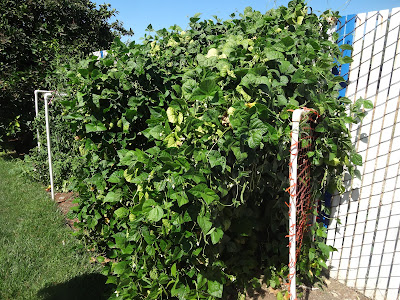This year I once again grew out the Carosello Massafrese. I planted out transplants on May 4th and had the first harvestable fruit by June 24th.
Early on in their growth, I mulched the garden bed with some pine needles. Though there were still some weeds to take care of, the mulch did a good job of reducing the weed pressure.
Though I always utilize soaker hoses in my garden, this is the first time that I had used a very high quality soaker hose. If you have had problems with soaker hoses in the past, I would highly recommend trying out a Teknor Apex. I have yet to find a soaker hose that gets really good reviews, but of all the soaker hoses I’ve tried, this one is definitely well worth the price.
While the taste of this specific carosello is very good, the moderate variance of coloring and patterns, the drought resistance and the productive nature of this carosello lent it to being one of the best carosello cucumbers that I grow.
The coloring of the Carosello Massafrese fruit exhibit a lot more of a light variance than it did last time I grew it. Though I enjoy the dark splotched bands, I don’t care much for the smaller dots. I believe that there are multiple reasons for this including the difference in climate between Tucson and Fairfield. Here in Fairfield, I have a lot of water, fertile soil and less intense light than I had in Tucson. Here the fruit grows faster and more productive than in Tucson, but there are some negative side effects. With faster growing fruit, the skin of the plant may grow too quickly. With less light, the dark skin coloring does not develop as well.
 |
| Transplanted May 4th, 2019. |
 |
| May 11th |
 |
| June 6th |
Early on in their growth, I mulched the garden bed with some pine needles. Though there were still some weeds to take care of, the mulch did a good job of reducing the weed pressure.
 |
| June 6th |
 |
| June 14th |
Though I always utilize soaker hoses in my garden, this is the first time that I had used a very high quality soaker hose. If you have had problems with soaker hoses in the past, I would highly recommend trying out a Teknor Apex. I have yet to find a soaker hose that gets really good reviews, but of all the soaker hoses I’ve tried, this one is definitely well worth the price.
 |
| June 21st |
While the taste of this specific carosello is very good, the moderate variance of coloring and patterns, the drought resistance and the productive nature of this carosello lent it to being one of the best carosello cucumbers that I grow.
 |
| June 24th |
 |
| June 29th |
The coloring of the Carosello Massafrese fruit exhibit a lot more of a light variance than it did last time I grew it. Though I enjoy the dark splotched bands, I don’t care much for the smaller dots. I believe that there are multiple reasons for this including the difference in climate between Tucson and Fairfield. Here in Fairfield, I have a lot of water, fertile soil and less intense light than I had in Tucson. Here the fruit grows faster and more productive than in Tucson, but there are some negative side effects. With faster growing fruit, the skin of the plant may grow too quickly. With less light, the dark skin coloring does not develop as well.

















































